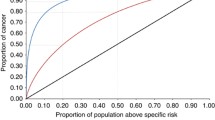Abstract
One of the clinical hallmarks of hereditary cancer susceptibility disorders is a younger-than-usual age at diagnosis. Familial aggregation of testicular germ cell tumor (TGCT) has been reported, but data on whether familial TGCT cases are diagnosed at an earlier age are inconclusive. Here we compared the age at diagnosis of familial TGCT cases with that of population cases in several countries. Familial TGCT is defined as affected individuals from families with ≥2 cases of TGCT. Age at diagnosis of familial cases from the United States, Canada, United Kingdom, Australia and New Zealand, Norway, and Hungary was compared to cases identified in population-based cancer registries from the respective country, using the generalized estimation equation method. Age at diagnosis was statistically significantly younger for familial TGCT cases from North America (P = 0.024), the United Kingdom (P < 0.0001), and Australia and New Zealand (P = 0.0033) compared with population cases. When stratified by histology, the difference in age at diagnosis distribution between familial and population cases was observed for seminoma cases from North America (P = 0.002) and the United Kingdom (P < 0.0001) and non-seminoma cases from the United Kingdom (P = 0.029) and Australia and New Zealand (P = 0.0023). In summary, we found that the age at diagnosis for familial TGCT cases is, on the average, 2–3 years younger than that for the population cases in North America, United Kingdom, and Australia and New Zealand. The younger age at diagnosis might be suggestive of a genetic basis for familial TGCT.

Similar content being viewed by others
Abbreviations
- ITCLC:
-
International testicular cancer linkage consortium
- TGCT:
-
Testicular germ cell tumor
References
Ferlay J, Bray F, Pisani P et al (eds) (2004) GLOBOCAN 2002: cancer incidence, mortality and prevalence worldwide. IARC Press, Lyon
Hemminki K, Sundquist J, Bermejo JL (2008) Familial risks for cancer as the basis for evidence-based clinical referral and counseling. Oncologist 13:239–247
Holzik MFL, Rapley EA, Hoekstra HJ et al (2004) Genetic predisposition to testicular germ-cell tumours. Lancet Oncol 5:363–371
Nicholson PW, Harland SJ (1995) Inheritance and testicular cancer. Br J Cancer 71:421–426
Heimdal K, Olsson H, Tretli S et al (1997) A segregation analysis of testicular cancer based on Norwegian and Swedish families. Br J Cancer 75:1084–1087
Harland SJ, Daugaard G, Horwich A et al (2006) The familial influence on bilateral testicular germ cell cancer: medical Research Council study TER2. Annual Meeting Proceedings. J Clin Oncol 24, Abstract no. 4590
Crockford GP, Linger R, Hockley S et al (2006) Genome-wide linkage screen for testicular germ cell tumour susceptibility loci. Hum Mol Genet 15:443–451
Rapley EA, Crockford GP, Easton DF et al (2003) Localisation of susceptibility genes for familial testicular germ cell tumour. APMIS 111:128–135
Knudson AG Jr (1985) Hereditary cancer, oncogenes, and antioncogenes. Cancer Res 45:1437–1443
Lindor NM, McMaster ML, Lindor CJ et al (2008) Concise handbook of familial cancer susceptibility syndromes—second edition. J Natl Cancer Inst Monogr 2008:3–93
Forman D, Oliver RT, Brett AR et al (1992) Familial testicular cancer: a report of the UK family register, estimation of risk and an HLA class 1 sib-pair analysis. Br J Cancer 65:255–262
Dieckmann K-P, Pichlmeier U (1997) The prevalence of familial testicular cancer. Cancer 80:1954–1960
Sonneveld DJA, Sleijfer DT, Schraffordt Koops H et al (1999) Familial testicular cancer in a single-centre population. Eur J Cancer 35:1368–1373
Dong C, Lonnstedt I, Hemminki K (2001) Familial testicular cancer and second primary cancers in testicular cancer patients by histological type. Eur J Cancer 37:1878–1885
Mai PL, Friedlander M, Tucker K et al. (2009) The international testicular cancer linkage consortium: a clinicopathologic descriptive analysis of 461 familial malignant testicular germ cell tumor kindred. Urol Oncol. doi:10.1016/J.urolonc.2008.10.004
Sokoloff MH, Joyce GF, Wise M (2007) Testis cancer. J Urol 177:2030–2041
Fossa SD, Chen J, Schonfeld SJ et al (2005) Risk of contralateral testicular cancer: a population-based study of 29 515 U.S. men. J Natl Cancer Inst 97:1056–1066
The International Testicular Cancer Linkage Consortium (1998) Candidate regions for testicular cancer susceptibility genes. APMIS 106:64–72
Parzen E (1962) On estimation of a probability density function and mode. Ann Math Stat 33:1065–1076
Liang K-Y, Zeger SL (1986) Longitudinal data analysis using generalized linear models. Biometrika 73:13–22
McCullagh P, Nelder JA (1989) Generalized linear models, 2nd edn. Chapman and Hall/CRC, London
Smith RA, Cokkinides V, Brawley OW (2008) Cancer screening in the United States, 2008: a review of current American cancer society guidelines and cancer screening issues. CA Cancer J Clin 58:161–179
Acknowledgments
We would like to thank Dr. Parry Guilford for his contribution to the familial TGCT cases. We also thank Istvan Gaudi (Cancer Registry of National Institute of Oncology, Budapest, Hungary) and Sue Westlake (Social & Health Analysis & Reporting Division, Office for National Statistics, UK) for their contribution from the cancer registries. This research was funded in part by the Intramural Research Program of the National Cancer Institute, National Institutes of Health, and supported by contracts N02-CP-11019 and N02-CP-65504 with Westat, Incorporated. The authors have no conflict of interest or financial disclosures to report.
Author information
Authors and Affiliations
Corresponding author
Rights and permissions
About this article
Cite this article
Mai, P.L., Chen, B.E., Tucker, K. et al. Younger age-at-diagnosis for familial malignant testicular germ cell tumor. Familial Cancer 8, 451–456 (2009). https://doi.org/10.1007/s10689-009-9264-6
Received:
Accepted:
Published:
Issue Date:
DOI: https://doi.org/10.1007/s10689-009-9264-6




